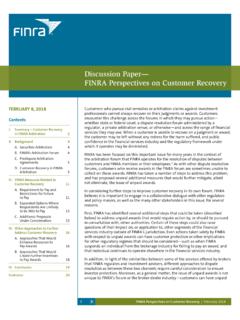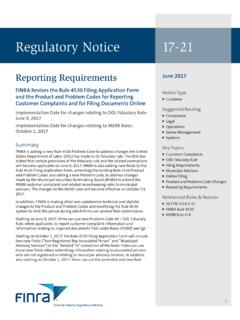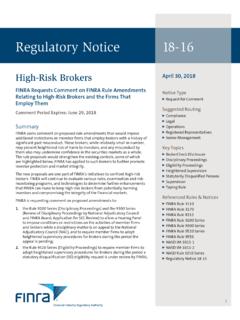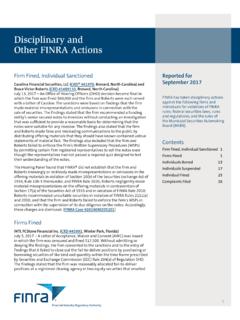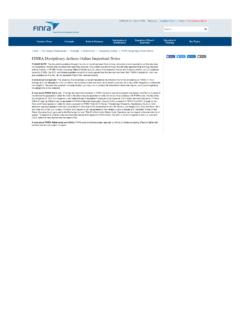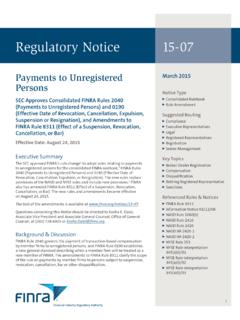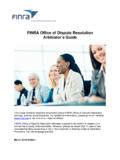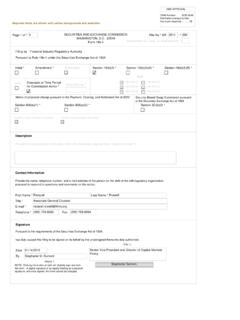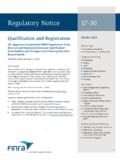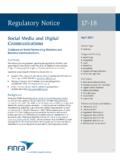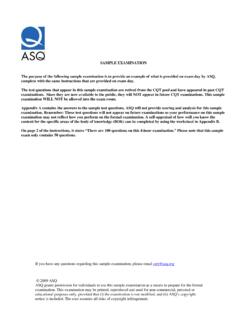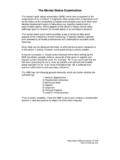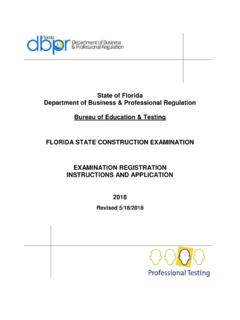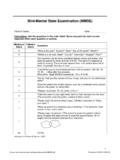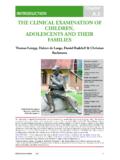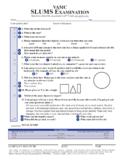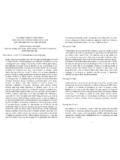Transcription of Report on FINRA Examination Findings
1 Report on FINRA Examination Findings | December 20171 CONTENTSH ighlighted Observations 2 Cybersecurity 2 Outside Business Activities and Private Securities Transactions 4 Anti-Money Laundering Compliance Program 5 Product Suitability 6 Best Execution 8 Market Access Controls 9 Summary of Additional Observations 11 Alternative Investments Held in Individual Retirement Accounts (IRAs) 11 Net Capital and Credit Risk Assessments 11 Order Capacity 12 Regulation SHO 13 TRACE Reporting 13 DECEMBER 2017 FINRA s Examination program plays a central role in supporting FINRA s mission of investor protection and market integrity. A main component of this program is FINRA s examinations of broker-dealers ( firms or members ) that are conducted on a regular cycle basis: each firm is examined at least once every four years, and many are examined even more frequently.
2 In connection with each of these examinations, FINRA prepares a Report which is available only to the relevant firm addressing certain aspects of the firm s compliance with securities rules and regulations. Firms are required to address issues identified by FINRA , and many do so by proactively taking corrective action before FINRA concludes its exam. Through this sort of rapid remediation, firms strengthen their compliance and supervisory programs, which ultimately helps better protect investors and the integrity of the is issuing this Report as another resource that firms can use to strengthen their compliance with securities rules and regulations. Some firms have requested that FINRA make generally available a summary of observations from the cycle Examination program, so that they can further improve their compliance functions based on the experiences of other firms, and better anticipate and address potential areas of concern well before their own cycle Report focuses on selected observations from recent examinations that FINRA considers worth highlighting due to their potential impact on investors and markets or the frequency with which they occur.
3 This Report does not represent a complete inventory of observations about the industry as a whole, does not imply that any issues discussed exist at any particular firms, and should not be read as creating new legal or regulatory requirements or new interpretations of existing requirements. An individual firm may not have any deficiencies in the risk areas identified in the Report also describes certain practices that FINRA has observed to be effective in appropriate circumstances, which other firms may be able to use as a resource in tailoring their compliance and supervisory programs to their business. There should be no inference, however, that FINRA requires firms to implement any specific practices described in this Report that extend beyond the requirements of existing securities rules and Report FROM THE FINANCIAL INDUSTRY REGULATORY AUTHORITYR eport on FINRA Examination FindingsReport on FINRA Examination Findings | December 20172 FINRA expects that this Report will evolve over time as we work to ensure that it is helpful in supporting firms compliance and supervisory efforts.
4 FINRA welcomes feedback on how we could make future reports on Examination Findings more useful. If you have suggestions, please contact Daniel M. Sibears, Executive Vice President, Regulatory Operations/Shared Services, at (202) 728-6911; or Steven Polansky, Senior Director, Regulatory Operations/Shared Services, at (202) ObservationsCybersecurityCybersecurity is one of the principal operational risks facing broker-dealers. Recent revelations regarding successful attacks at a number of different entities underscore the need for firms to be vigilant in addressing cybersecurity threats. FINRA has focused on sharing information to help firms better protect their customers and themselves, including through recommendations offered in connection with an The primary federal securities law provision governing a firm s cybersecurity program is SEC Rule 30 of Regulation S-P, which requires firms to have written policies and procedures addressing the safeguarding of customer information and has seen a significant increase in firms attention to cybersecurity challenges over the past two years, including at the executive management level.
5 Awareness about cybersecurity risk has increased substantially. Most firms we examined have established, or were establishing, risk management practices, although the quality of those practices varied substantially both within and across firms. In some cases, firms adopted and executed, on an ongoing basis, formal risk management practices that executive management approved and applied on a consistent, firmwide basis. And some of the firms we regulate are leaders in developing and adopting cutting-edge cybersecurity with effective cybersecurity programs typically established strong governance structures and processes (scaled to the firm) that addressed cybersecurity in a risk management context. Firms escalated risk acceptance decisions and problems to the appropriate levels for resolution, as well as to inform future program development.
6 Measures firms implemented included regular risk assessments with detailed, time-bound follow-up action plans to resolve higher-risk concerns. Firms supported these assessments with regular vulnerability and penetration tests. Firms also required employees to participate in regular, role-specific and generic cybersecurity training and testing, for example, through phishing email exercises. Firms with branch offices developed and implemented robust branch cybersecurity reviews as part of their branch Examination programs. As appropriate to their scale, some firms implemented security information and event management, system usage behavior analytics and data loss prevention tools to identify, monitor, and address potentially anomalous or suspicious activity on their on FINRA Examination Findings | December 20173 Selected Examination FindingsAs the nature and sophistication of cybersecurity threats continue to evolve, even robust cybersecurity programs can be compromised when, for example, an employee opens an email attachment that contains malware.
7 Common threats FINRA observed in 2016 and 2017 include phishing and spearphishing attacks,2 ransomware attacks and fraudulent third-party wires that frequently involve use of email or stolen customer or financial advisor observed a variety of areas where some firms could improve their cybersecurity programs against these and other These areas include:00 Access Management Some firms FINRA examined did not address basic access management issues such as terminating departing employees access to firm systems on a timely basis. In the case of privileged systems users, some firms did not implement procedures to log, monitor and supervise their activities to detect anomalies such as a privileged user assigning herself or himself extra access rights, performing unauthorized work during off-hours or logging in from different geographic locations Assessments Some firms did not have formal processes to conduct ongoing risk assessments of their data, systems and applications, and could not effectively identify their critical assets and the potential risks to those Management Some firms did not have formal processes to review a prospective vendor s cybersecurity preparedness or to ensure new vendors have appropriate protections in place.
8 For example, some firms contracts with vendors did not address key questions such as the vendor s responsibilities regarding notification to the firm in the event of a breach of customer or firm data. In cases where firms contracted with a parent organization for cybersecurity services, the parent s cybersecurity responsibilities were not sufficiently documented, such as in a service-level Offices FINRA found that firms branch offices typically faced greater challenges in managing passwords, implementing patches and software updates, updating anti-virus software, controlling removable storage devices, encrypting data and reporting of Duties FINRA observed some medium- and small-sized firms that did not segregate the responsibilities for requesting, implementing, and approving cybersecurity rules and systems changes.
9 For example, some firms allowed application developers to access sensitive data in production systems and in some cases implement application code into production without appropriate oversight. In other cases, network engineers performed cybersecurity and information security functions without formal management Loss Prevention FINRA observed that while larger- and medium-sized firms had implemented data loss prevention tools, there were opportunities to strengthen those implementations, including broadening rules that prevent transmission of Social Security numbers to include additional sensitive data such as customer account numbers; establishing thresholds to flag or block large file transfers to outside and untrusted recipients; and implementing formal change-management processes for data loss prevention system rule on FINRA Examination Findings | December 20174 Outside Business Activities and Private Securities Transactions FINRA Rules 3270 and 3280 require registered representatives to notify their firms of proposed outside business activities (OBAs), and all associated persons to notify their firms of proposed private securities transactions (PSTs), so firms can determine whether to limit or allow those activities to proceed.
10 Certain OBAs and PSTs could potentially involve misconduct or create conflicts of interest that may expose both firms and customers to potential risks. The notifications required in the rules assist firms in identifying and determining how to mitigate those risks, including by placing conditions on, or prohibiting, participation in the proposed OBA or that had effective programs to manage OBAs and PSTs typically implemented proactive compliance efforts, particularly at the branch level. Firms used frequent training to make registered or associated persons aware of their responsibilities with respect to OBAs and PSTs, including the requirements to provide a firm prior written notice of a proposed activity. Firms also required these individuals to complete open-ended questionnaires and attestations regarding their involvement or potential involvement in OBAs and PSTs on a regular basis.
